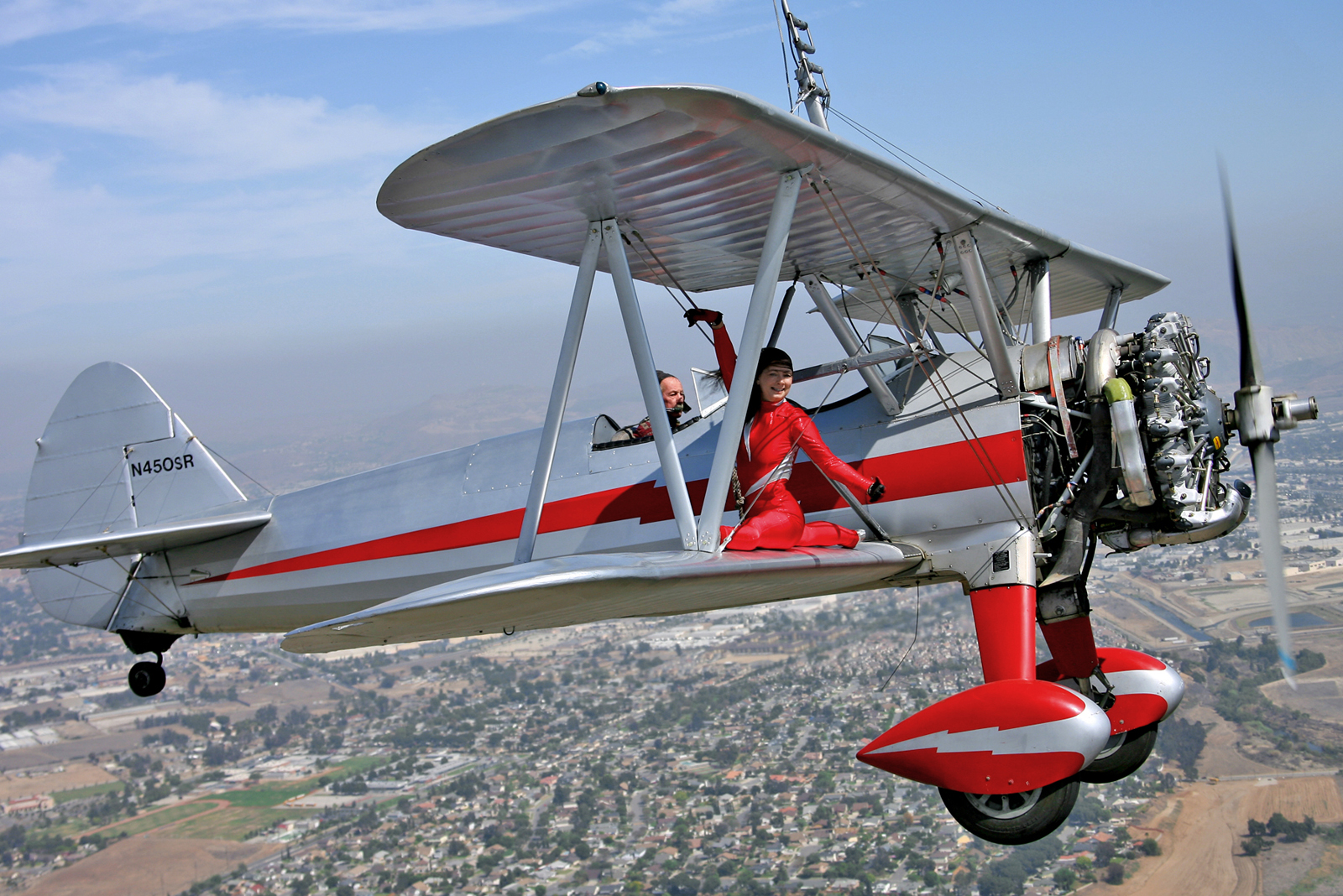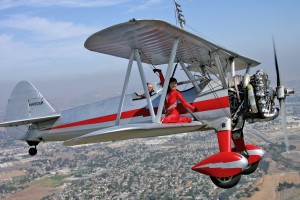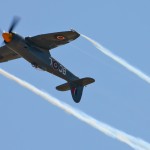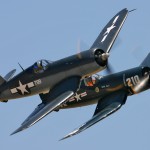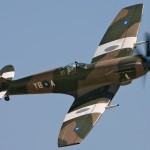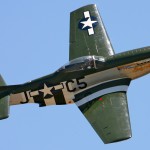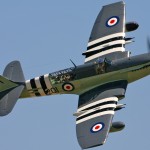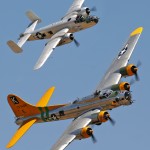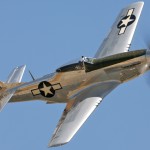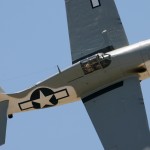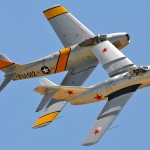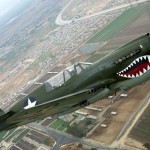By Victor G. Archer
The Planes of Fame Air Museum presented its 23rd air show at Chino Airport (CNO) in Chino, Calif., May 17-18. This year’s theme, “Wings of the Silver Screen,” recognized aviation’s role in the motion picture industry. The historic aircraft that performed at the show have appeared in many films, including “30 Seconds Over Tokyo,” “Flying Tigers,” “The Flying Leathernecks,” “Pearl Harbor,” “Midway,” “Tora! Tora! Tora!,” “Baa Baa Black Sheep,” “Fighter Squadron,” “Saving Private Ryan,” “The Hunters,” “The Bridges at Toko-Ri” and more. The Planes of Fame Air Show also featured wing walking, warbird formations, aerobatics, an F-16 Viper demonstration and Heritage Flight, and the famous airpower flyover with more than 20 warbirds.
The show started with a classic wing-walking performance from Silver Wings, featuring pilot Hartley Folstad, wing walker Margi Stivers and their Stearman biplane. Stivers thrilled the spectators with her unique poses, such as upside down splits, standing splits, victory pose, back-layout off the wing rack, the N strut “aerobesque” and handstand on the top wing. Stivers performed her 1,100th wing walk during the show.
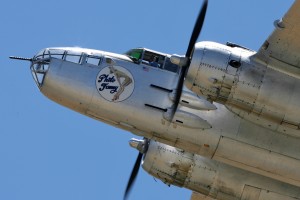
The Planes of Fame Museum’s B-25, Photo Fanny, makes a low-level pass during the salute to the Doolittle Raiders’ attack on Tokyo.
Next was a salute to the Doolittle Raiders’ attack on Tokyo. Two North American B-25 Mitchells—the Museum’s own B-25 Photo Fanny and the Aero Trader’s B-25 Pacific Princess—took to the air, making several mock bombing runs and flying figure-eight patterns around the field. These aircraft have appeared in many movies; both the Pacific Princess and Photo Fanny took off from the aircraft carrier USS Constellation for the movie “Pearl Harbor” in September 2000.
Aerobatics pilot Steve Hinton, flying Rod Lewis’s 1945 Grumman F8F-2 Bearcat, put on a first-rate demonstration, which included loops, rolls and high-speed passes.
A large group of aircraft representing those that fought in the Pacific Theater was in the air next. The first two aircraft to go up were the Douglas Dauntless flown, by Ron Hackworth, and the only known airworthy Grumman F3F Flying Barrel, piloted by Rob Paterson. The F3F was the Navy’s last shipboard biplane fighter prior to World War II. Other aircraft flying in this group included a Lockheed P-38 Lightning flown by Steve Hinton, a North American P-51A flown by John Hinton, a pair of Curtiss P-40 Warhawks piloted by Mark Moody and Jim Thomas, a pair of Japanese-built Mitsubishi Zeros piloted by John Maloney and Jason Somes, a Japanese Aichi D3A Val flown by Tom Nightingale, Grumman FM2 Wildcat and F6F Hellcat piloted by Tom Camp and Ken Gottschall and a Chance Vought F4U Corsair flown by Mark Foster.
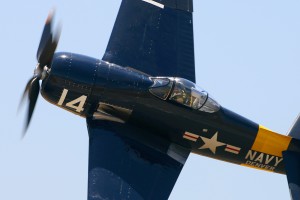
Steve Hinton performed thrilling aerobatics demonstration in Rod Lewis’s 1945 Grumman F8F-2 Bearcat.
During the re-enactment, the Japanese Val dive-bomber, escorted by the two Zeros, made a run on the field. The Zeros then departed to fly top cover, getting into a dogfight with the two P-40s and P-38. Also joining in on the air battle was a rare P-51A. The Allied aircraft chased off the Japanese Val and then made several low-level passes in front of the crowd line.
During a short break from the show in the air, the California Historical Group put on a military ground combat demonstration that included a Sherman tank and many other armored vehicles from both Allied and Axis powers. The re-enactors wore uniforms representing U.S., British, German and Russian soldiers from the WWII era.
Back to the action in the sky, a group of aircraft representing the Korean air war included a Stinson L-5 Sentinel, several North American T-6 Texans, F-51 Mustangs and a pair of Chance Vought F4U Corsairs. Also flying in this group were some of the early jet aircraft, including a Lockheed T-33 Shooting Star, North American F-86 Sabre and Russian MiG-15. Most of the fighter aircraft made several low level passes, while Steve Hinton, at the controls of a North American F-86 Sabre, and Chris Fahey piloting the MiG-15, put on a riveting tail-chase routine across the sky.

Rob Paterson flew the only known airworthy Grumman F3F Flying Barrel during the air war over the Pacific demonstration.
The next flying demonstration was breathtaking. The Horsemen, Jim Beasley and Ed Shipley, performed a two-ship formation routine, with both pilots flying P-51 Mustangs. Shipley, in Wee Willie, flew right on Beasley’s wing, in Spam Can, as they performed a series of loops and rolls. They then maneuvered to a stacked formation, with Shipley underneath and a little behind Beasley, and once again performed a loop and a roll. Throughout the entire routine, they were never more than a few feet apart.
Following the Mustangs were the bombers and little friends of the European Theater, a flying display of bombers and fighter escort aircraft. The first two planes up were the museum’s own B-25, Photo Fanny, and a Boeing B-17G Flying Fortress, Fuddy Duddy. The two bombers made passes in tight formation while being followed by a pair of P-51D Mustangs, Lady Alice, flown by Ken Wagner, and Kimberly Kay, piloted by Tony Banta. Joining this group was Eddie Kurdziel, flying his beautifully restored Fairey Firefly AS-6, one of only three Fireflies in airworthy condition. John Maloney went up in the museum’s 1944 Griffin-powered Spitfire Mk XIV, along with Kevin Eldridge in rare 1942 Republic P-47G Thunderbolt. Joining this rare and unique group was Jeff Harris in a Lockheed P-38 Lightning. The P-38 was originally bought for $1,250 in 1946 from the giant aircraft bone yard at Kingman, Ariz.

This Douglas SBD Dauntless, flown by Ron Hackworth, is a WWII veteran, having flown 30 combat missions over Rabaul. This aircraft has also been in the movies “Midway” and “War and Remembrance.”
Several Reno unlimited racers were at Chino, and spectators witnessed an historic moment as Steven Hinton flew Bill “Tiger” Destefani’s highly modified P-51 Mustang racer, Strega, along with Mark Watt in Brian Sander’s modified Hawker Sea Fury, Dreadnought, powered by massive 4,360 cubic inch, 28-cylinder engine. Steven Hinton, Steve Hinton’s son, is one of the youngest pilots to solo in a Mustang, and this was the first time he flew at an air show. Strega, the Mustang he flew, is one of the fastest racing Mustangs at the Reno National Championship Air Races, and with Destefani at the controls, has won the Unlimited Gold Race six times.
A flight of four bent-wing birds then took to the air in a tribute to the TV series, “Baa Baa Black Sheep,” with the F4U Corsairs making several single and formation passes for air show fans. MGM Studios once owned the museum’s own Corsair, an F4U-1, which appeared in the TV series. Goodyear built two of the Corsairs, which are FG-1D models; these two aircraft have crossed paths many times during their lives. One Corsair, owned by Rod Lewis, is Bu. # 67070; it was on the assembly line with Bu. #67087, owned by Chuck Wentworth. After the war, both saw service in the El Salvadoran Air Force as FAS-202 and FAS-211. The fourth Corsair was a later-model F4U-4 with a four-bladed prop; this aircraft recently returned to the U.S. after spending the last 10 years in France.

A Japanese Aichi Val flown by Tom Nightingale was converted from a Vultee BT-15 Valiant for the movie “Tora! Tora! Tora!” It also appeared in the movie “Pearl Harbor.”
Brian Sanders’ Sea Fury aerobatic routine was a treat for the crowd. With smoke generators on the wingtips, Sanders put his Sea Fury, Argonaut, through an amazing performance filled with high-speed loops, rolls and passes. It was more like watching a military-style demonstration than just aerobatics.
The mass airpower formation flight is something seen only at Chino’s air show. Aircraft in this year’s group included two P-38s, four P-51s, two P-47s, two P-40s, F6Fs, four B-25s, a Spitfire, two B-25’s and a B-17. This special formation usually numbers 20 to 30 aircraft flying at one time, and is truly an awe-inspiring sight.
The U.S. Air Force F-16 Viper tactical demonstration team took to the sky with high-speed maneuvers, including a knife-edge pass, high-G turns and mock ground attacks. The F-16 Viper’s design allows it to perform air-to-air and air-to-ground missions at low altitude, day or night, and in all weather. After the demonstration, a P-51 Mustang and P-38 Lightning, flown by Hinton, joined in for the USAF Heritage Flight.

Curtiss P-40 Warhawks, piloted by Mark Moody and Jim Thomas, are another pair of aircraft that flew during the air war over the Pacific demonstration.
Other aircraft, military vehicles and aviation-related items were on display for guests to see close-up. The show also provided spectators the opportunity to experience the thrill of flying in a warbird, such as the P-51 Mustang and P-40 Warhawk. A great variety of food and memorabilia was available from vendors, as well as information booths from the U.S. Air Force, National Guard, San Bernardino County Sheriffs Department and more.
Planes of Fame was the first permanent air museum on the West Coast, and is a major center for restoring aircraft to flying condition. Donations and admission fees provide most of the operating funds for the museum, staffed by a group of dedicated volunteers.
For more information about the Planes of Fame Air Museum and air show, visit [http://www.planesoffame.org].
- Brian Sanders flew his Sea Fury, Argonaut, through an amazing aerobatic performance filled with high-speed loops, rolls and passes.
- Steven Hinton, one of the youngest pilots to ever license in a P-51 Mustang, gets ready to go up in one of the fastest racing Mustangs ever built, Strega.
- Steven Hinton, piloting Bill “Tiger” Destefani’s highly modified P-51 Mustang racer, Strega, flew alongside Mark Watt in Brian Sander’s modified Hawker Sea Fury, Dreadnought.
- Shown are two of four F4U Corsairs that made formation and single passes in a tribute of the TV series “Baa Baa Black Sheep.”
- Kimberly Kay, piloted by Tony Banta, went into service in South America in the 1960s. After delivery to El Salvador as FAS-401, it eventually made it back to the U.S. and was restored by Dave Teeters of Airmotive Specialties Inc. in Salinas. Calif.
- Kimberly Kay, piloted by Tony Banta, went into service in South America in the 1960s. After delivery to El Salvador as FAS-401, it eventually made it back to the U.S. and was restored by Dave Teeters of Airmotive Specialties Inc. in Salinas. Calif.
- The Indian air force purchased this Supermarine Spitfire Mk.XIV, flown by John Maloney, in 1947. It eventually became a gate guardian and was returned to the UK in 1979. Today this beautifully restored Spitfire is part of the POF Museum’s collection.
- Lady Alice, a North American P-51D-30NT Mustang owned and piloted by Ken Wagner, makes a pass.
- Captain Eddie Kurdziel flies his beautifully restored multi-award winning Fairey Firefly AS-6. It’s one of only three Fireflies still flying today.
- This rare Lockheed P-38L Lightning, piloted by Jeff Harris, has had a rough life, surviving several crashes. Harris is restoring it and keeping it in flying condition.
- Photo Fanny, a B-25 Mitchell, and Fuddy Duddy, a Boeing B-17G Flying Fortress, made several tight formation passes during the air war over Europe flight demonstration.
- Jim Beasley and Ed Shipley, “The Horsemen,” put on an amazing display of formation flying. Throughout the entire routine, they were never more than a few feet apart.
- This beautiful, highly polished P-51D-25NA Mustang, owned by Jack Croul, served with the 190th Fighter Squadron and then with several ANG units. Jeff Harris recently restored the aircraft.
- A Grumman FM2 Wildcat, piloted by Tom Camp and restored in 2002, represents the USN WWII Atlantic Theater camouflage paint scheme. Camp also races his Wildcat at the Reno National Air Races as Air Biscuit.
- Steve Hinton is at the controls of the museum’s Lockheed P-38J Lightning, one of only five remaining J model Lightnings and the only one in flying condition.
- Steve Hinton, piloting a North American F-86 Sabre, and Chris Fahey, piloting the MiG-15, put on a great tail-chase/dog-fight routine for air show guests.
- John Hinton is at the controls of the Planes of Fame Museum’s Curtiss P-40N Mk IV, originally delivered to the Royal Canadian Air Force in 1943. This aircraft was eventually restored and used in the 2000 version of the movie “Pearl Harbor.”
- Chris Fahey pilots the Planes of Fame Museum’s Chance-Vought F4U-1A Corsair, which flew in the TV series “Baa Baa Black Sheep.”











